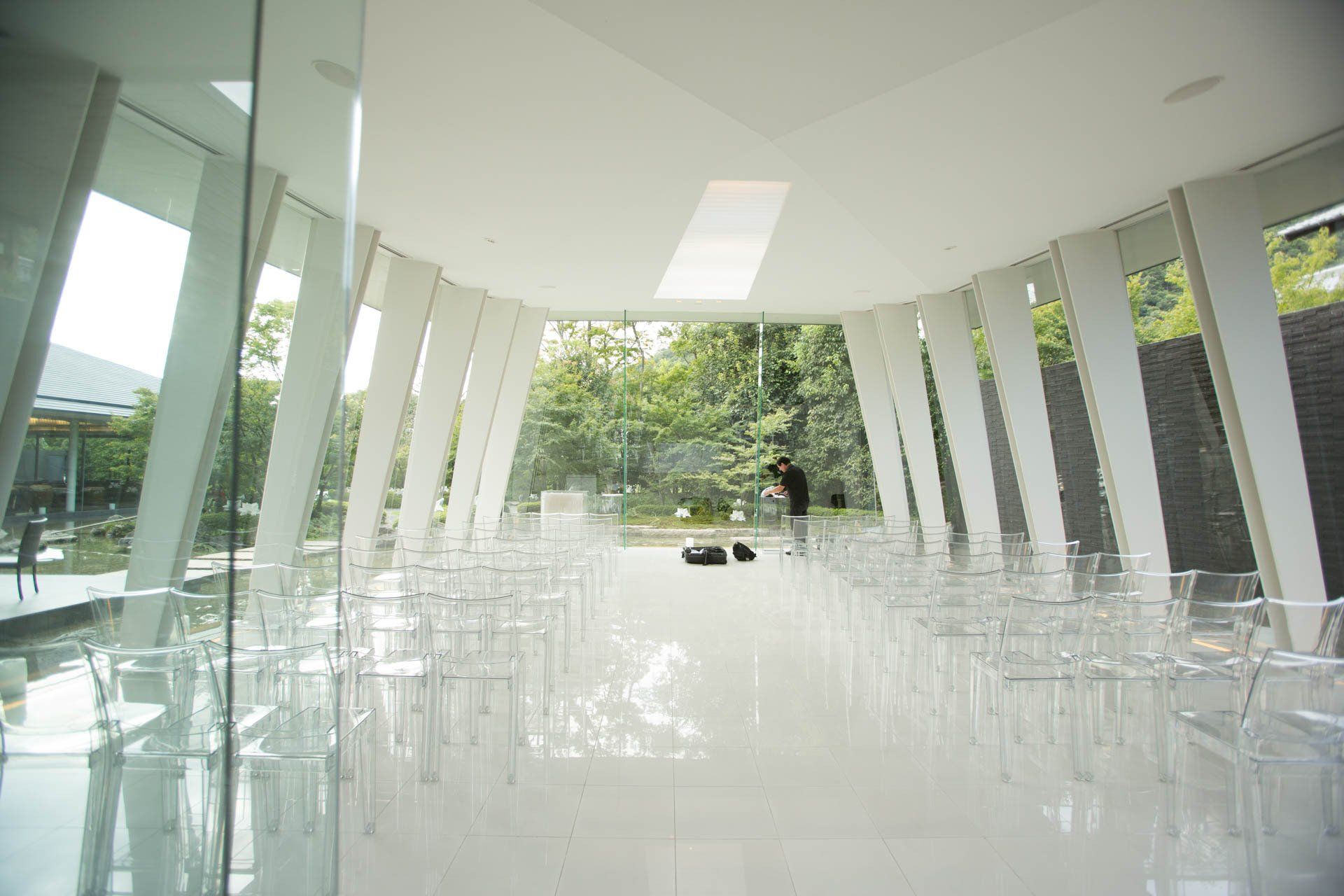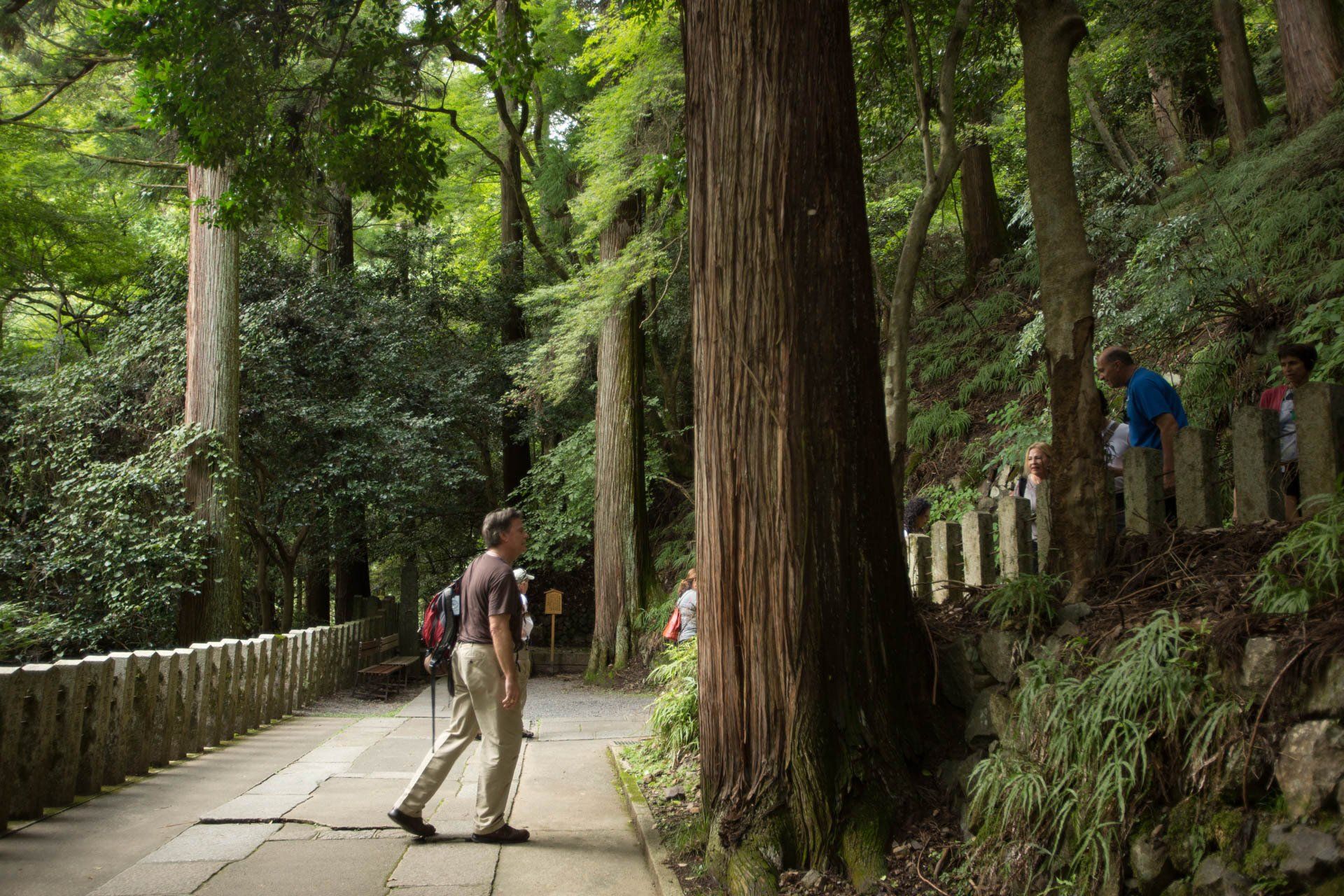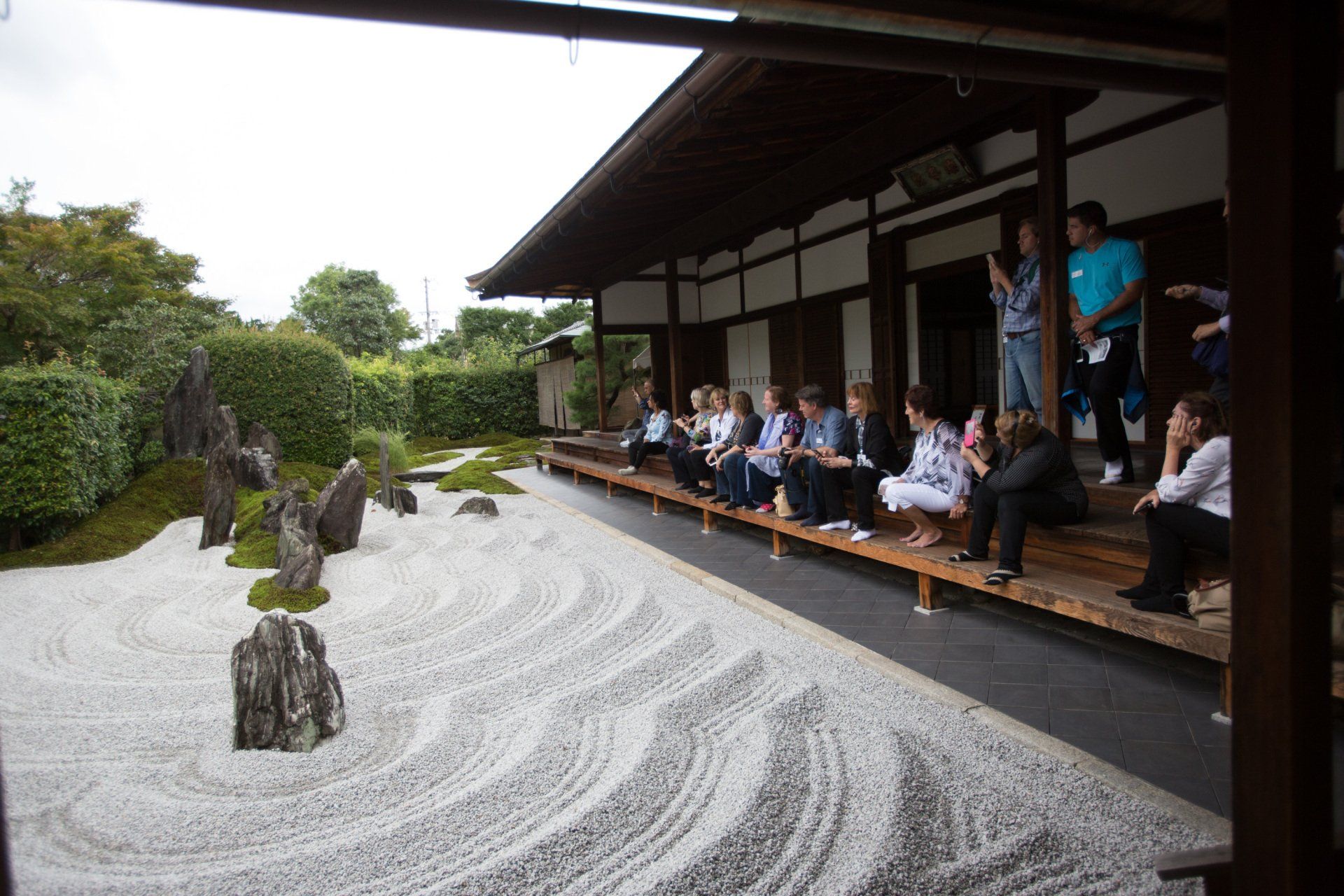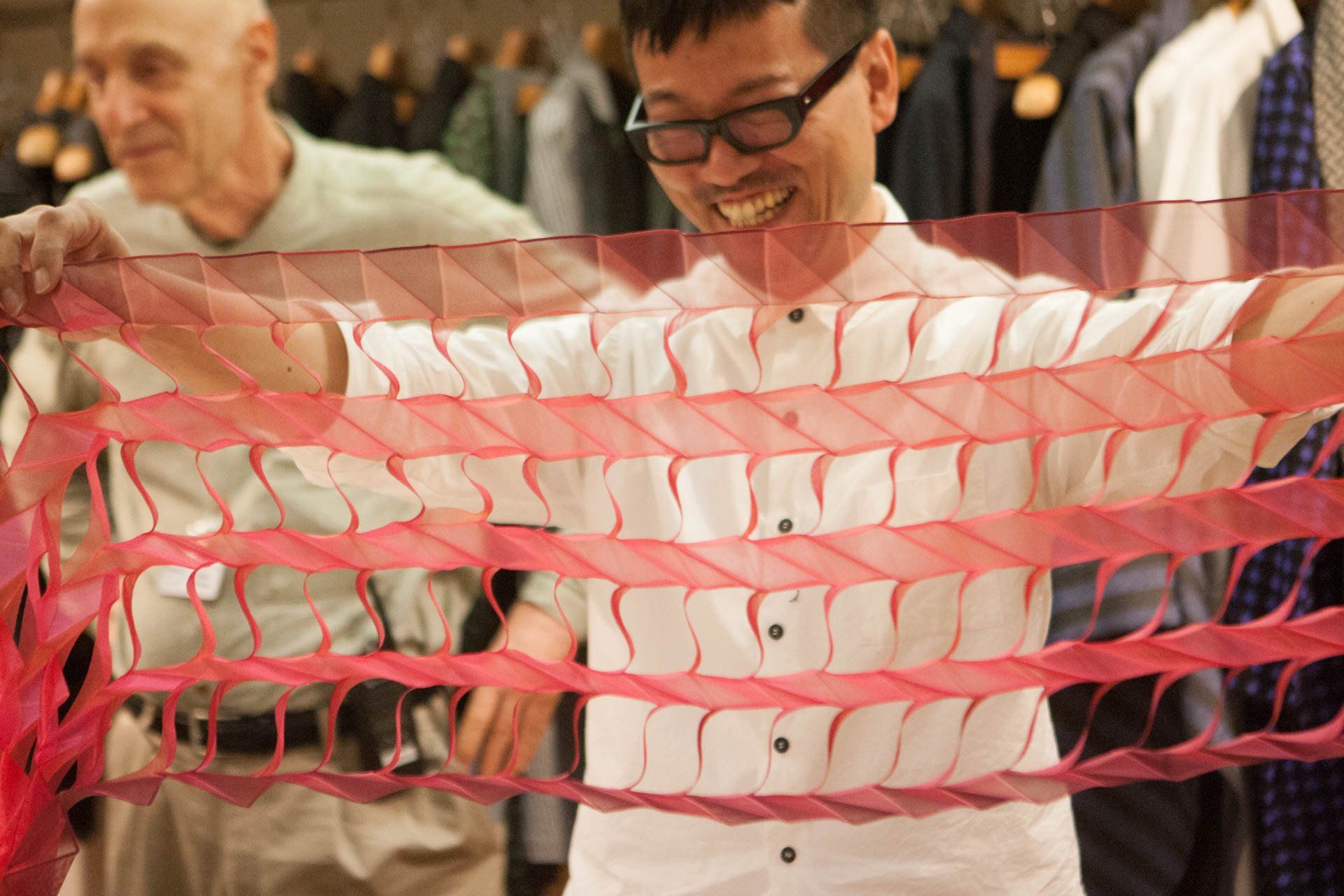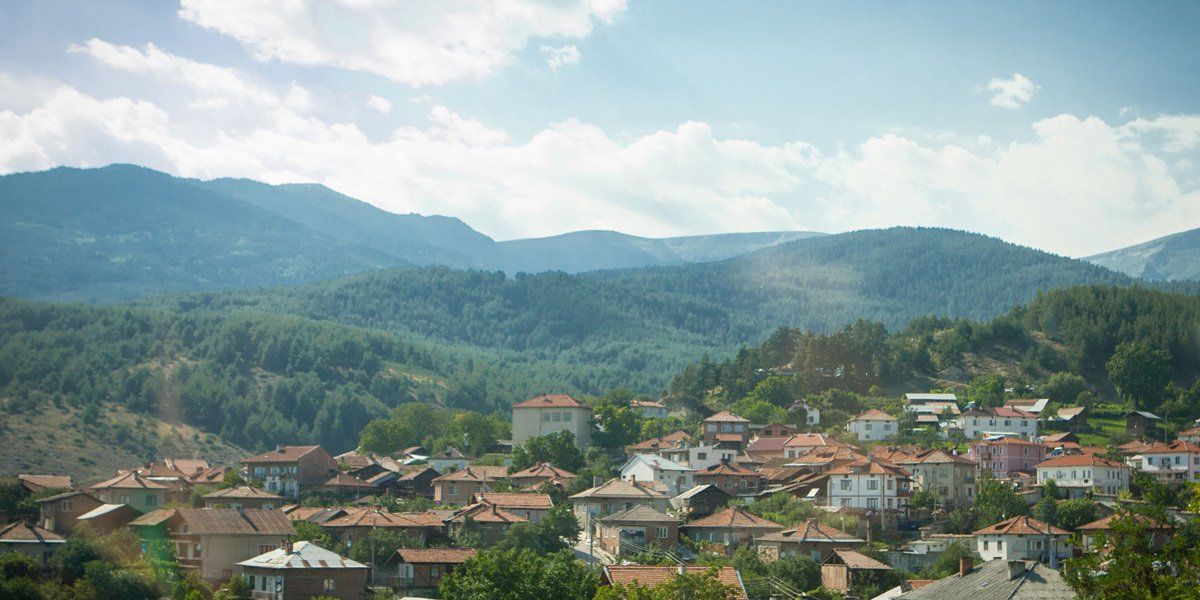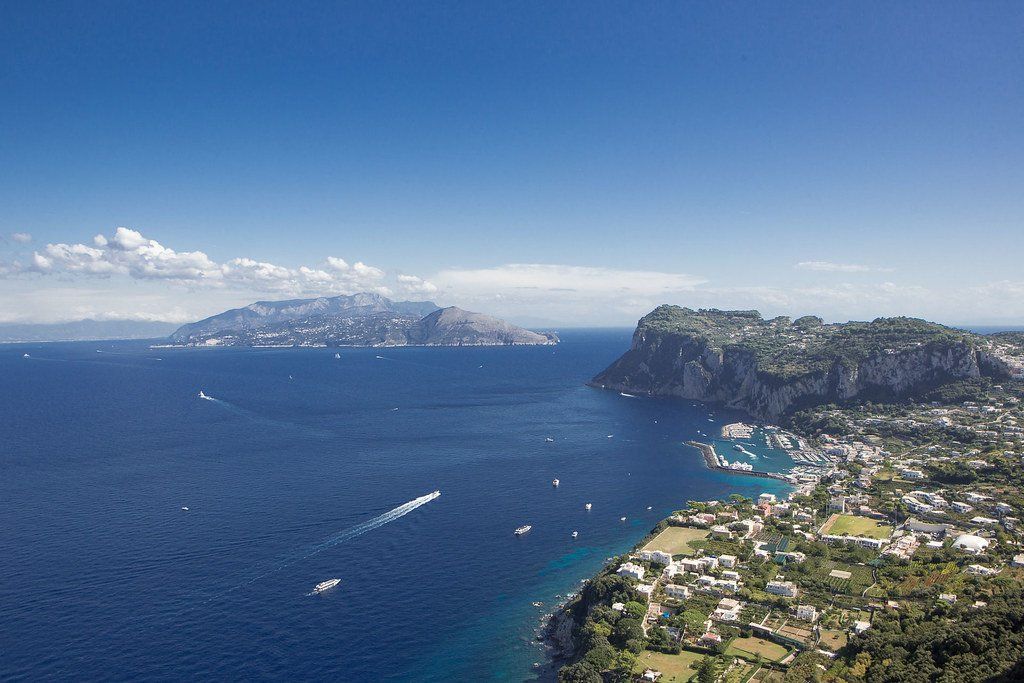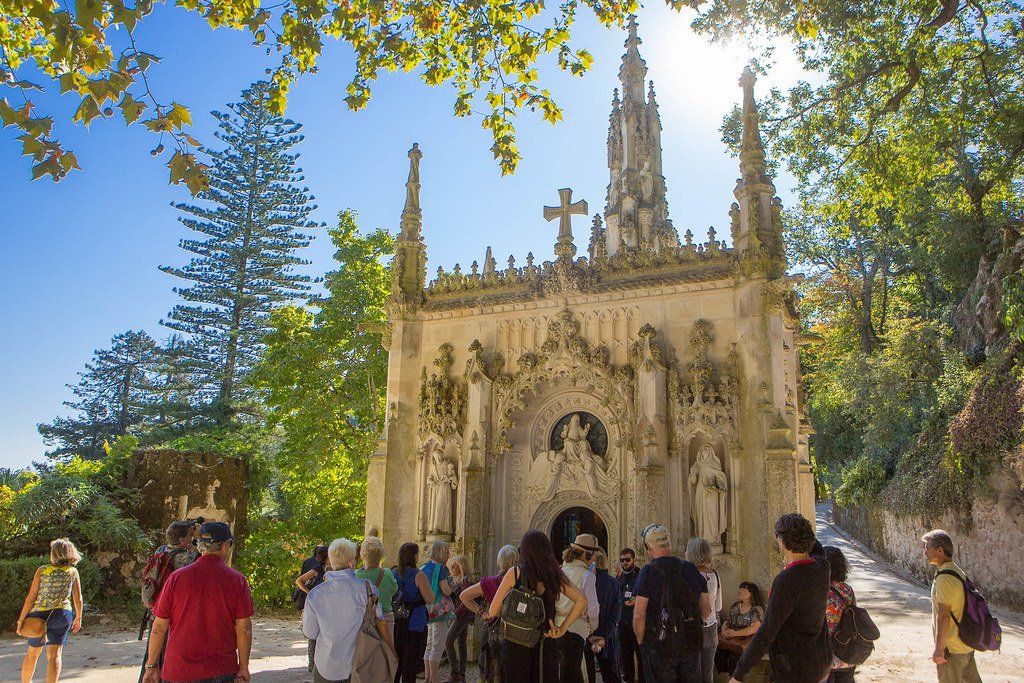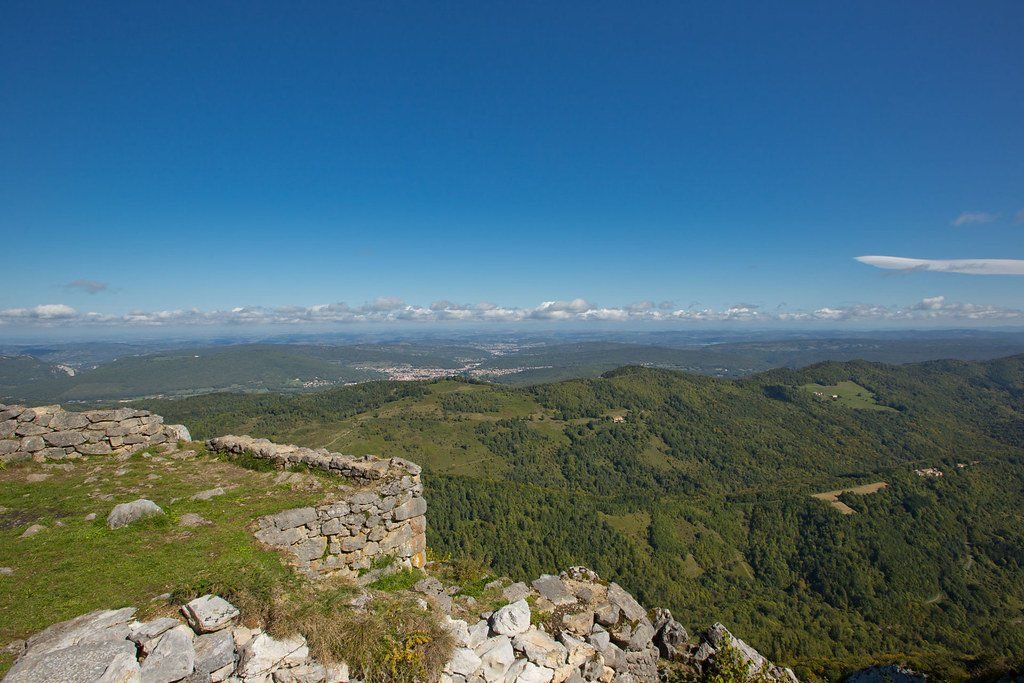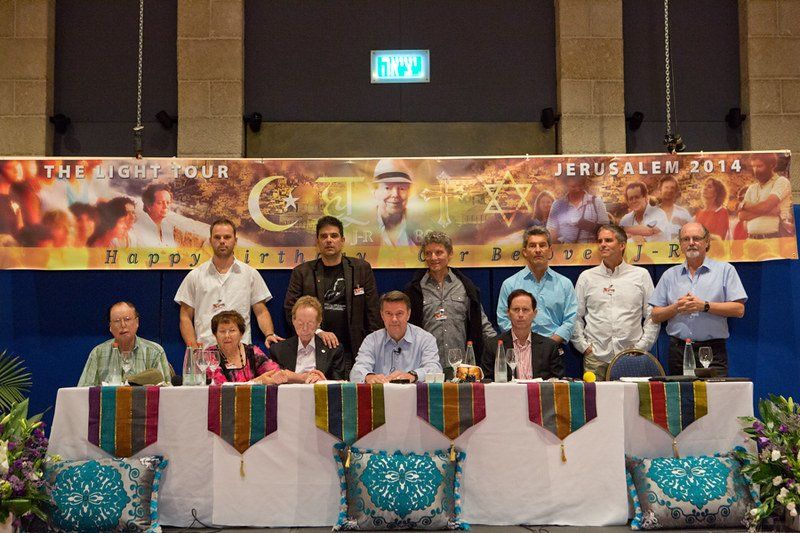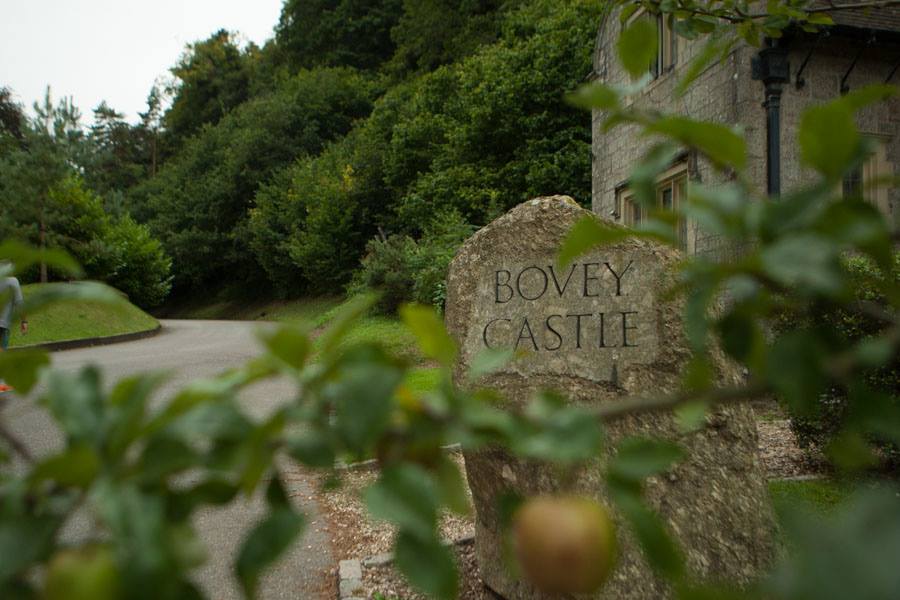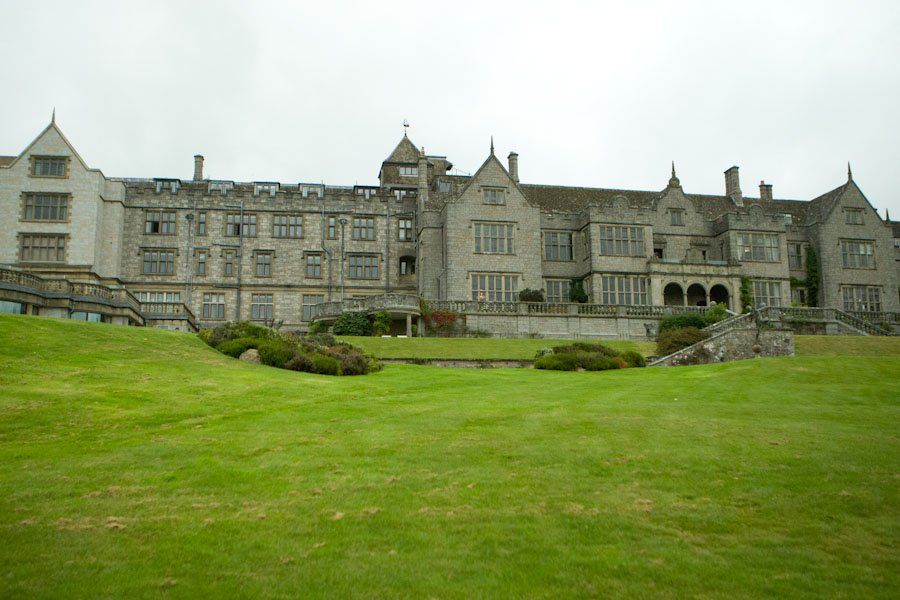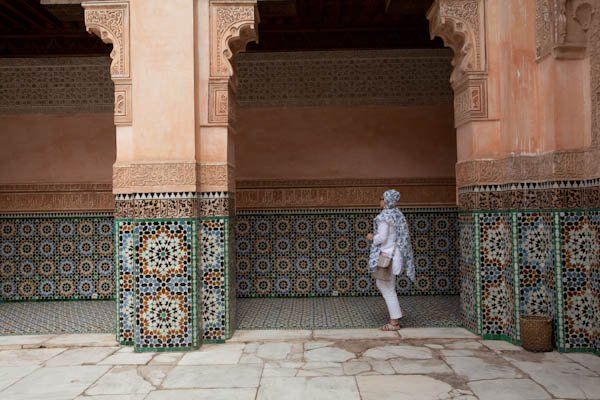Zen of the Mystical Traveler - Japan 2016
Tokyo - Mt. Fuji - Matsumoto - Kyoto - Shuzen-ji - Tokyo
Dates: September 23 - October 4, 2016
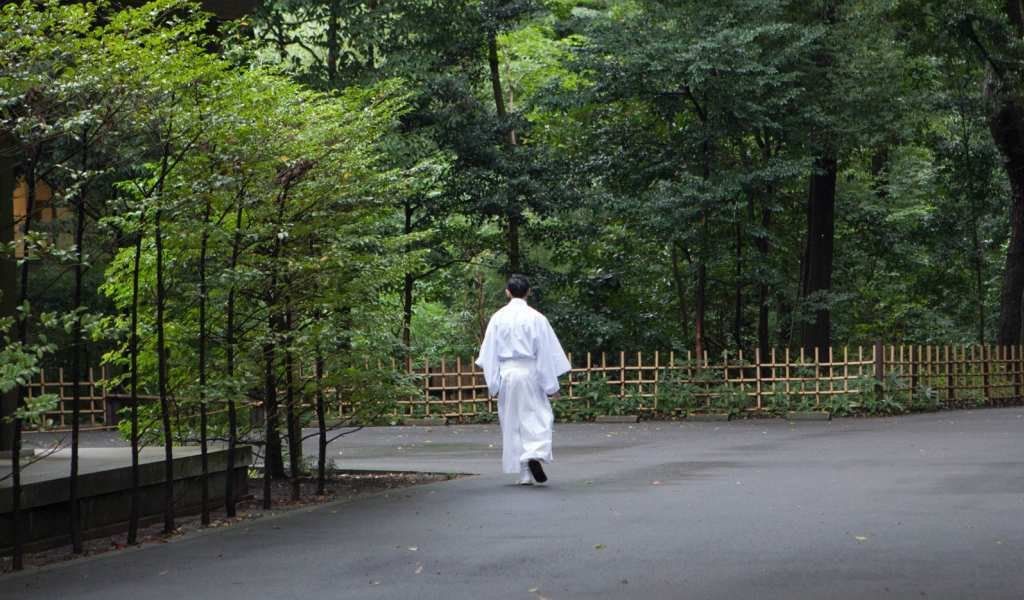
John Morton and staff went on a 10-day tour of Japan with over 60 participants in late-September, 2016. In addition to the main tour, a Benefactors extension of 3 nights at the end of the tour included private sharing and unique experiences.
Daily Events
List of Services
-
Day 1 - September 23 - TokyoList Item 1
Arrival and relaxation.
Overnight: Palace Hotel Tokyo
-
Day 2 - September 24 - TokyoList Item 2
From Julie Lurie: We began our day with a visit to the Meiji Shrine with John Morton calling in the Light and moving us into morning spiritual exercises. Meiji Jingu is a Shinto shrine that was established November 1, 1920. Shinto is an ancient religion thought to be the original religion of Japan. In opposed to being dedicated to a deity or holy book, Shinto is dedicated to harmony in nature and virtues such as purity of the body and heart. The Meiji Jingu Shrine is breathtaking wooden structure constructed in a style reminiscent of the Forbidden City. It is nestled within a 100-year old forest made up of 120,000 trees imported from all over the world, especially Japan. Made primarily of Japanese cypress and copper, the shrine is dedicated to Emperor Meiji and Empress Shokan. The shrine was built in an iris garden in an area that the Emperor and Empress were known to frequently visit.
The name Meiji means “enlightened rule” or “enlightened peace”. The Emperor’s given name was Mutsuhito. Emperor Meiji was Emperor of Japan from 1867-1912. During this reign Japan was transformed from a feudal country into one of the great world powers of the modern world. Emperor Meiji is known for the waka poetry that he wrote during the course of his daily life out of his enjoyment for the art. Emperor Meiji learned waka poetry from his father and began writing waka poems at the age of eight. Waka are very short poems that contain no more than thirty one syllables. Because Emperor Meiji wrote his waka poems with such heartfelt sincerity instead of for attention or critical acclaim, his poems have become appreciated for their realism and sincerity, impacting the lives of many. Emperor Meiji wrote about 100,000 poems and became known as the “Sage of Poetry”. Only about 500 of Emperor Meiji’s waka have been made public.
We then joined in a Meiji Kaguru Ceremony which is a 20-minute performance of Shinto offertory dance by Miko to the accompaniment of gagaku players. A Miko is a shrine maiden with a history dating back to prehistoric Japan. Nowadays, most Miko are often seen working at Shinto shrines, where they assist with shrine functions, preform ceremonial dances, sell souvenirs, and offering fortune telling. Gagaku is an ancient-style instrument which originally came to Japan from the Silk Road in the 700’s. The Meiji Kaguru Ceremony is an exciting glimpse into the traditions of Japan.
Back on the bus again and heading off to Omotesando. An architectural and fashion showcase for Asia, Omotesando is a long, tree-lined boulevard that was built in a style reminiscent of the Champs-Elysees, a beautiful Parisian boulevard with a history dating back to the 1700’s. Omotesando was built in the late 1800’s. Omotesando is a vivid masterpiece that marries the lush landscapes of nature with the advancements of humankind. The last three blocks of Omotesando showcase the flagship stores of Japan’s most famous fashion designers, including Issey Miyake, Yohji Yamamoto and Rae Kawakubo of Comme des Garcons. Here one can focus on the architectural importance of these buildings and their important place in both the world and in Tokyo.
For the grand finale of the day we were surprised with a traditional Japanese wedding for our own Mystical Traveler and Beloved wife, Leigh Taylor-Young at the Wadakuru Fountain Park Restaurant. As we arrived, we received of the beautiful music of the Shakuhachi Player as we moved into spiritual exercises. As the music faded, we gazed out through the open glass windows to see the Bride and Groom arriving for the wedding ceremony in full Kimono attire. The wedding began with a beautiful tea presentation by our very own Steve Beimel followed by a Shinto Priest chanting the wedding Sutra, moving into an MSIA ceremony. The Wadakuru Fountain Park restaurant offers an extensive menu of tasty Japanese foods and breathtaking views all from an intricately designed venue. It was a night we could not forget.
Overnight: Palace Hotel Tokyo
-
Day 3 - September 25 - TokyoList Item 3
From Julie Lurie: We began our day with a tour of Shinjuku. Shinjuku is a historical and cultural development from what was once Shogun’s feudal city to a bustling, modern district of Tokyo. Shinjuku is home to the busiest railway station in the world and is the government center of Tokyo. It is in Shinjuku that you will find many of Tokyo’s tallest buildings and exciting points of interest, such as the bright and energetic Kabukicho and shopping in Koreatown.
The Shibuya district found its home initially as the site of a castle in which the Shibuya family resided from the 11th century up through the Edo period. It has since advanced into a world center of youth culture, commercialism, entertainment and trend-setting, cutting-edge fashion. This is the location of the famous scramble crossing, a 5-way intersection that stops all vehicles in order to allow pedestrians to overwhelm the entire intersection at the same time. Because of the heavy traffic and large amounts of onscreen, bright advertising signs, Shibuya Crossing has been compared to Times Square in New York City. The scramble crossing has been shown in many films, including Lost in Translation.
As we stood all huddled together in the center of the famous scramble, John Morton to our delight planted a Column of Light.
Off to window shopping in the famous Ginza district in Tokyo known for its upmarket shopping and high concentration of internationally renowned department stores. It is in Ginza that you’ll find enough luxury goods to satisfy any expensive taste, among a sparkling atmosphere and a ritzy itinerary. For five hours every day, the main shopping street is closed to traffic and caters to pedestrians, ensuring a peaceful and enjoyable afternoon of stress-free shopping. The district ebbs seamlessly from a shopping hotspot to an iridescent nightlife as nighttime advances, quickly becoming one of the best places to admire the neon lights Tokyo is so famed for. The nightlife scene is renowned for being mature, tasteful, and relatively peaceful.
After our morning adventure lunch (for the Benefactors) was next with another beautiful Blessing by John Morton at the Argo Restaurant.
Overnight: Palace Hotel Tokyo
-
Day 4 - September 26 - Tokyo
From Julie Lurie: Stepping out of the taxi onto the grounds of Happo-En Gardens I felt transported into paradise in the middle of Tokyo. Proudly complete with a history of over three hundred years, Happo-en Gardens is an Edo-era attraction once home to important samurai and the founder of the Hitachi Corporation. Nowadays the Happo-en gardens are a beautiful setting in which many events, such as weddings, often take place. It is set within a beautifully maintained garden with a pond, waterfall and two traditional teahouses where you can enjoy a selection of matcha tea and sweets. You can even learn how to participate in a traditional tea ceremony and what types of tools and etiquette are involved. The gardens are often the backdrop for both Shinto style and western style weddings.
As we gathered in the beautifully exquisite venue room we participated in the exhibition showcasing the works of Masamitsu Saito, Japan’s leading private collector of one-of-a-kind bamboo baskets, as well as Masami Oguchi, whose gallery is one of only two in Japan specializing in bamboo art.
Since one cannot get enough shopping in Tokyo or maybe I am only speaking for myself and many of us jumped into and taxis and headed off into the world of fashion, textiles and beauty for one last shopping spree in Tokyo. 21_21 Design Sight is a small museum dedicated to contemporary design. The museum was created by architect Tadao Ando and fashion designer Issey Miyake. It is dedicated to promote understanding and interest in civil engineering and design from all members of the public, from the educated to the inexperienced.
Combining traditional Japanese technique with modern technology, Nuno is one of the world’s top textile designers. The original and distinctive textiles produced at this cutting edge company are featured in museums all around the world. Perhaps quite appropriately, the word “nuno” is Japanese for “fabric”. This is a must see if you are planning a visit to Tokyo.
Overnight: Palace Hotel Tokyo
-
Day 5 - September 27 - MatsumotoList Item 4
From Julie Lurie: As we arrived at the Fuji Sanctuary the staff greeted us as if we were royalty. Our beloved Leigh Taylor-Young in 1990 featured the magnificent flag ceremony that the Society of Prayer for World Peace presents around the world and produced this event in the General Assembly at the United Nations. Some of the staff that greeted us had worked with Leigh at this time and with great enthusiasm welcomed us.
The Fuji Sanctuary is a famous attraction dedicated to unification and peace. It is here that people of all religions, backgrounds, and nationalities take a moment to reflect on their shared hope for world peace and mentally contribute to the positive virtues of the sanctuary. Fuji Sanctuary is a positive environment where nature is respected and humanity is celebrated. You can enjoy the sanctuary by means of quiet strolls on forested trails and pensive moments spent in the Prayer Field.
The proud home to the Fuji Sanctuary, Byakko Shinko Kai is a self-proclaimed “spiritual organization” dedicated to world peace and the gratitude to nature. Perceiving that the earth is moving into an elevated spiritual dimension, the organization believes that humanity must evolve with it. Byakko Shinko Kai takes pride in its positive mantras and peaceful philosophy, uniting people worldwide.
After viewing the breathtaking views of Mt. Fugi we traveled to Matsumoto Castle, circa 1595, which is one of the few remaining castles from Japan’s feudal period that is still in its original condition. It takes its name from its home city Matsumoto, and because of its black exterior it is also called “crow castle”. The castle is called a “hirajiro”, meaning it was built on a plain instead of a hill or a mountain. Its defenses included walls, moats, and gatehouses. Today it is listed as a National Treasure of Japan.
To top off our evening we indulged at a traditional Japanese Ryokan followed by a John Morton Seminar to send us off into never never land only to awaken to the sounds of creeks, birds and nature stirring about with a cool morning breeze. The Myojinkan ryokan facility is a traditional Japanese inn that caters to the comfort and pleasure of its guests. The style, atmosphere, and service of the ryokan is considered to be more important than modern conveniences, and it is at a ryokan that travelers experience true Japanese hospitality and a taste of the country’s authentic culture. The Myojinkan Ryokan is a beautifully simplistic inn nestled within the tranquil mountainside of Shinshu, Matsumoto. It is the perfect place to relax and enjoy a peaceful glimpse into rural Japan.
Overnight: Myojinkan Ryokan
-
Day 6 - September 28 - Kyoto
From Julie Lurie: As we awoke to a light rain in Matsumoto and boarded the bus to Narai Juku, upon arrival we experienced the Japanese torrential rain storm, also known as “typhoon” in Japanese. Nakasendo is the famous and historic road that cuts through the mountains and curves along with the Kiso Valley, connecting Kyoto to the capital city in Edo. The carefully and traditionally restored town of Narai Juku was once a prosperous inn town and is now recognized by its unique architectural style and overhanging second floors. The town is a quiet retreat from the hustle and bustle of Japan’s larger cities and is the perfect stop for tasty food, traditional ryokans, and true Japanese hospitality.
With soaked clothes and wet socks we traveled onto Kyoto. Kyoto is a beautiful and colorful city located on the Japanese island of Honshu. The city was once the capital of Japan and is now a one stop destination to enjoy classically designed Buddhist temples, refined gardens, traditional wooden houses, complex Shinto shrines, and intricate imperial palaces. Kyoto is renowned for its preservation of formal traditions such as kaiseki dining and geisha entertainment. The city comes across as borderline surreal, with sublime secrets attraction hiding within the mountainside and a rainbow of colors from the fuchsia flowers to the sparkling blue sky.
Upon arrival in Kyoto the hotel staff greeted us bowing and with beautiful smiles of delight. We were whisked off to the venue room with equipment cases in hand for the kick off seminar in Kyoto for all. And, what a seminar it was!! You’ll have to watch the seminar for all the surprises.
Overnight: Hyatt Regency Kyoto
-
Day 7 - September 29 - Kyoto
From Julie Lurie: Grace descends upon us as we began our morning with group Spriritual Exercises in a Buddhist temple. The Daitokuji Obai-in is a beautifully appointed 450 year-old Buddhist sub-temple within the larger Daitokuji monastery complex. It is the head temple of the school of Japanese Zen Buddhism. Founded in 1319, Daitokuji has become linked to the master of the Japanese tea ceremony, Sen no Rikyu. It is home to various additional complexes, included 13th century artwork by the Chinese artist-monk Mu Qi. Obai-in is an autonomous sub temple of Daitokuji and within the complexes visitors can explore numerous gardens, outdoor wooden corridor walkways and teahouses.
As we strolled through the temple and gardens we came upon the tea training room, of which our very own Steve Beimel attends tea ceremony classes! The Zuiho-in garden is an authentic and traditional Japanese garden in the sub-temple of Zuiho-in in the complex of Daitokuji. The main garden is designed as a dry landscape and is notable for the sand raking that represents a rough sea. The garden is also enhanced by tall and pointy stones along with a small stone bridge. Within Zuiho-in there are a couple of tea rooms, which are at times used by the tea community for traditional Japanese tea ceremonies.
After a morning of Spiritual Exercises, monks, and tea ceremonies it was time for lunch. After lunch, our next adventure is Noh Theater. Noh Theater is the world’s oldest continuously performed theater, with a history boasting back to at least six hundred years. Noh Theater specializes in classical Japanese musical dramas and is recognized by the unique characteristics notable throughout the performances. At the Noh Theater Workshop we were introduced to the general aspects of a Noh play, including their stylized movement, their musical instruments, their chanting (similar to Greek chorus), costumes and of course, their famous masks.
Overnight: Hyatt Regency Kyoto
-
Day 8 - September 30 - Kyoto
From Julie Lurie: For the early morning risers, a special 5:30 am chanting service was available. Chishakuin Temple is the head temple of the Shingon Buddhism Chizan Sect and is the less conventional choice for travelers. It has beautiful Shoheki-ga panel paintings considered national treasures, as well as a beautifully maintained garden. The temple is centered on a beautiful, glass like pond that extends under the temple. Chishakuin has a history dating back to the 14th century and was established in 1598. It is the center of Buddhist learning and training and is composed of over forty monks. There is a morning chanting service that is followed by a fire ceremony where the prayers of individuals are written on wooden sticks and then burned.
For those of us who need some coffee in the morning before we kick started our day at a bright 8:00 am. We ventured off to Kitayama Monolith which is a beautiful event facility built in contemporary Japanese architectural-style. It is often the venue for weddings and other special events. Kitayama Monoloth also serves high end fine dining cuisines against a backdrop of breathtaking scenery.
We gathered in the beautiful glass venue as John shared with the group. After sharing a beautiful lunch was served and only to be surprised again by Taiko Drummers! WOW!
For those who love to hike the next stop was a mountain climb. For the rest of us we enthusiasticly went shopping in Kyoto. Northwest of Kyoto looms Mt. Kurama, a stretching mountain of nearly two thousand feet. What makes it particularly notable, however, is the legends behind it. Mt. Kurama is said to be the birthplace of the Reiki practice, a holistic healing art. Reiki is said to have been developed when Mikao Usui meditated on Mt. Kuruma for 21 days and received healing powers. Mt. Kuruma is also the birthplace of Sojobo, the mythical King of the Tengu. The Tengu, legendary creatures found in Japanese folk religion, are said to have taught swordsmanship to Minamoto no Yoshitsune, a famous war general from the early Heian and late Kamakura periods.
Overnight: Hyatt Regency Kyoto
-
Day 9 - October 1 - Kyoto
From Julie Lurie: After being seranaded by spirit with group Spiritual Exercises we headed out west of the Kyoto foothills to the Tenryu-ji Rinzai Zen Monastery in Arashiyama. The temple is a historic site surrounded by unique and breathtaking landscapes. Tenryu-ji was established in 1339 in memory of Emperor Go-Daigo and was finished in 1345. Tenryu-ji Rinzai Abbot Hall is home to one of Kyoto’s most renowned and illustrious gardens, boasting a history that dates back to the 1300’s. This breathtaking pond was designed with illusionary techniques, complex manipulation of pond shape and arrangement, carefully planned site dimensions, and borrowed scenery in order to give the perception of a greatly expanded space.
After your senses are filled deeply with spirit and beauty, we walk a bit furthur to experience another peaceful garden with bright yellow butterflies dancing through the bushes of flowers as if playing hide and seek with one. Hogo-in Villa is a 200 year old property where visitors can explore the garden and house while admiring the sukiya-style architecture. This historic setting offers an authentic glimpse into traditional Japanese culture and an opportunity to enjoy a tranquil and peaceful atmosphere. The garden is landscaped of simplistic moss, making it incredibly pleasant for a quiet walk.
Lunch time is here! As we sit down on little pillows on the tatami mats we are met with creamy homemade tofu. Yudofu Sagano Restaurant is a restaurant that specializes in servicing various forms of tofu based meals, including the special silky and creamy tofu for which Kyoto is famous. The dining experience, while somewhat casual, is enhanced by a charming and traditional atmosphere. There is both indoor and outdoor seating for maximized enjoyment.
Overnight: Hyatt Regency Kyoto
-
Day 10 - October 2 - Kyoto
From Julie Lurie: Today we met the MSIA Japanese Community!! Wow, this was quite a day for all of us to connect with the community of Japan with hugs, laugher and tears of joy as we boarded the bus for group spiritual exercises at Joju-in Temple. Joju-in Temple is a section of the Temple Kiyomizu-dera, a World Heritage Site located in Kyoto, Japan. The temple, which was established in 1219, is acclaimed for its traditional Japanese gardens and a featured pond that is bestowed with two beautiful islands. Joju-in was built to bring good fortune and to protect the ruling Hojo Clan during times of danger and war. The contemporary temple overlooks the 400 year old Garden of the Moon and offers a glimpse into Japan’s rich and distinguished history.
After touring, we headed off for lunch followed by another amazing seminar with John Morton at Pulse Plaza!
Overnight: Hyatt Regency Kyoto
-
Day 11 - October 3 - Kyoto
From Julie Lurie: Upon walking on the land at the Renge-ji temple for preparation for the morning group spiritual exercises, the Zen of Spirit swept through my consciousness as if I was in a dream whilst gazing out upon the temple gardens. The Renge-ji Temple is a minimalistic Buddhist temple of the Shingon sect located northeast of Kyoto. The temple itself finds its home in a Zen atmosphere surrounded by the trickling of brooks, a charming pond in the center of the traditional gardens, and a lush and quiet forest landscape. While the exact date of construction is not mutually agreed on, a document inside the temple dates the current structure of the temple to 1812 CE. Dubbed by many as a “secret paradise”, Renge-ji is an unexpected and perhaps underestimated detour that is well worth a traveler’s time.
After a light lunch and an afternoon of Japanese dance, Ikebana, music and a martial artist we moved into an evening with the Traveler to celebrate and share the loving to all bursting full of the Zen of Spirit.
Overnight: Hyatt Regency Kyoto
-
Day 12 - October 4 - Depart/Benefactors
From Julie Lurie: The final days are spent with the Benefactors and sharing with John Morton in the delightful Asaba Ryokan as the grand finale. The Asaba Ryokan is an upscale Japanese guesthouse nestled in a tranquil environment and complimented by a self-proclaimed “festive atmosphere”. The rooms are stunningly simplistic and the views of the rural Japan countryside are breathtaking. At Asaba you can take advantage of the many things this “ryokan” has to offer, including both indoor and outdoor hot springs, a spa, and incredible shows, including delectably pure Japanese cuisine.
Many have all wished each other Sayonara with tears in their eyes and tidings of joy, happiness, gratefulness and oneness of sharing this time with each other. And for those who are enjoying the last moments of the Japan Tour 2016 we send you love and Light with hopes and wishes of another one to come in the future.
God Bless Japan and All those who participated and especially all those around the world who joined us sharing your loving with us and sending the Light and may you all dream tonight as the Zen of the Mystical Traveler travels with you forever more.
Signing off from Japan. Loving and Light to All, God Bless us All, Love Julie
Overnight: Asaba Ryokan
-
Day 13 - October 5 - Benefactors - Tokyo
Transfer today from Shuzen-ji to Tokyo for final touring and a grace-filled private dinner overlooking the city lights.
Overnight: Four Seasons Marunouchi at Tokyo
-
Day 14 - Depart to Home


